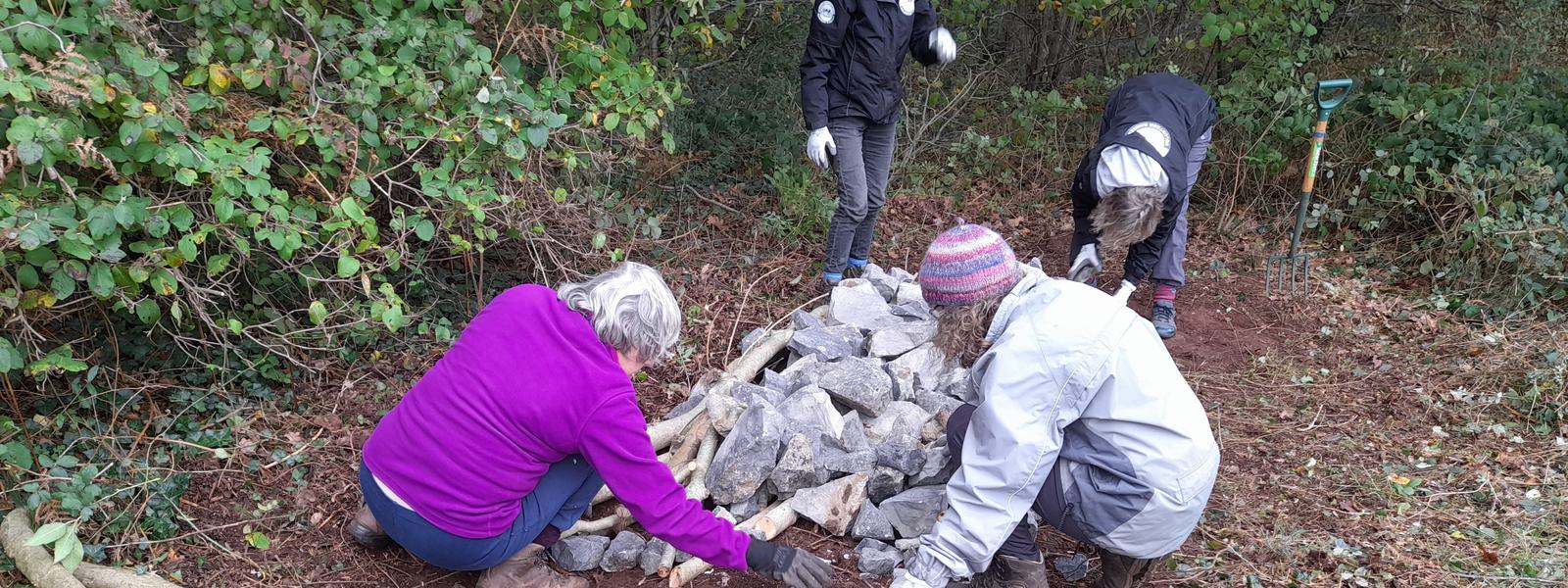Overview
To benefit one of our champion species, the adder, 5 hibernation sites (hibernacula) have been built across Mendip with the help of volunteers, experimenting with three different shapes. These included monitoring stations to provide much needed data on the needs and preferred hibernation habitats of this amazing creature.
Fostering a high level of partnership with landowners of all types (NGO’s, private and public) has been key to the project, as has raising the awareness of the plight of our reptiles.
What was done
Mendip is one of the last strongholds for the adder, the reptile suffering the greatest and most dramatic decline in numbers (according to ARG UK), but even here it has faced issues with habitat loss and fragmentation.
This is exacerbated by the fact that we have a limited understanding of what these amazing and elusive reptiles need to survive and thrive in our landscape. This is particularly true regarding their overwintering and hibernation needs and how, where and with what, we need to create hibernacula.
Working with numerous partners including Avon Wildlife Trust, National Trust, Bristol Water and other private landowners, we identified habitat that is suitable for these reptiles and provided additional hibernacula that adders could use to help recover their range.
The three designs were horseshoe, long barrow and round barrow (5 of each shape have been created); with a monitoring tube incorporated into the build for us to measure the temperature and humidity within the voids that form the heart of the hibernaculum.
These are believed to be the important considerations when creating spaces these animals will winter.
We created 2 key focus sites, one with Avon Wildlife Trust and one with National Trust, where all three hibernaculum designs were installed, using a mix of AONB staff and volunteers and the volunteers and staff of our partners.
We also worked with private and corporate partners, including Mendip Outdoor Pursuits, Forestry England, Bristol Water and others to create a network of hibernacula sites to provide additional data.
Outcomes
- We created 15 hibernacula of at least 2m in length and 1.5m in height and width.
- The Project used a total of 144 days of volunteer time.
- 5 team members from Avon Wildlife Trust, 3 team members from National Trust, 1 member of staff from Bristol water and 2 contractors from Deeper Green Services were all trained in how to identify suitable hibernaculum sites, what materials to use when creating them and then how to construct a hibernaculum.
- Presentations and talks on the hibernaculum project included 100 members of staff from Mendip Outdoor Pursuits, ARG UK Adder training day at Avalon Marshes center with 20 attendees from conservation organisation, including The Hawk and Owl Trust, RSPB, Natural England and somerset wildlife trust, 40 children from schools and D of E groups.
- Creation of a ‘How to build an adder hibernaculum’ guide which is available from the Mendip Hills AONB website.
- 5 private landowners, and 4 NGO’s engaged in the hibernaculum creation and monitoring scheme, including 2 regenerative farms, Bristol Water, Forestry England and The Butterfly Conservation Trust.
- Radio interview with BBC Radio Somerset to raise awareness of the plight of the adder and the hibernaculum project.
One of the most significant outcomes of this project has been the heightened engagement of our team in adder spotting. By creating hibernacula specifically tailored to the needs of this species, we’ve not only provided a haven for adders during the colder months but also increased awareness and appreciation for these fascinating reptiles. The project has also enhanced the overall biodiversity of our site. The careful management and restoration of the surrounding woodland and grassland areas, in conjunction with the hibernacula, has created a more favourable environment for a range of species. We have observed an increase in wildlife activity, including the return of rare plant species and the establishment of new habitats.
David Eddins - Managing Director
Key learnings
Partnership working was the key to the success of this project.
This was a landscape-scale project which has brought together many land owners and managers from across the Mendip Hills National Landscape to help an iconic species reclaim some of its range and to help future conservationists and ecologists by gathering meaningful data and observational records to help this species recover.
Courtesy of the Mendip Hills National Landscape.
